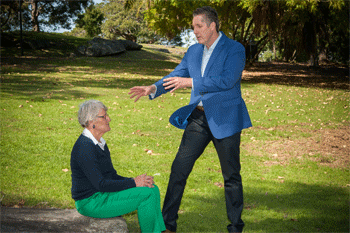Mark Stephens Hypnosis Interview

Mark Stephens Hypnosis Interview
As a nation, we're one of the biggest consumers of chocolate in the world, consuming 4.9 kilograms per capita each year*. After three days of Easter eggs, chocolate bunnies, and hot cross buns many Aussies are ready to kick the chocolate addiction.
40-year old former competitive ballroom dancer Hollie Blackert had been a chocoholic for as long as she can remember, consuming the equivalent of 3kgs of sugar every week. 'I got the habit from my mother and I'm worried about the example I am setting for my daughter and the effect it has on my health," says Hollie.
'I ate chocolate everyday - M&M's, Freckles, Cadbury Block and chocolate donuts. Chocolate milk was my favourite - I drank two litres every morning. I had a chocolate bar during the day and could eat one to two litres of chocolate ice cream every night. I didn't eat it because I was hungry - I was actually full from dinner. But every meal had to be finished with chocolate or it didn't feel right."
According to lifestyle hypnosis expert and author Mark Stephens from Think Slim, a chocolate addiction goes much further than an occasional treat or a few extra Easter eggs. Severe addicts often label themselves as 'chocoholics' and are unable to survive even a day without their favourite sugar hit. Chocolate elevates the happiness brain chemicals, serotonin and dopamine, which are the same chemicals released by the brain when sexually aroused and when high on cannabis.
After interviewing 1,000 overweight people, Stephens concluded the number one junk food people craved or were addicted to was chocolate, with 57% of those surveyed admitting to over-indulging in the sugary treat every day. "Some people reach for chocolate to comfort themselves or to self-medicate in an attempt to regulate their mood, while others just consume it out of habit," he says.
"Chocolate is both a mental addiction and a physical addiction, with people eating chocolate to feel good," says Stephens. Being stressed, tired, lonely, bored, sad and feelings of guilt are some of the most common reasons people give for their over-consumption of chocolate."
Stephens claims that in just a few minutes he can have even the most severely addicted chocoholics overcome their addiction and never wanting to touch chocolate again. He uses a unique combination of therapeutic techniques including hypnosis and aversion therapy.
"Hypnosis works by disconnecting the unconscious triggers and rewiring the mind to make healthy choices. With aversion therapy, we have the chocolate addict subconsciously associate chocolate with something that repulses them like dog droppings," he explains.
Hollie has now been chocolate free for four weeks after Marks' hypnosis session and is already 6 kg lighter. Her goal is to reach 65kg in four months.
Mark's Top Tips to Beat Chocolate Addiction
Avoid having it around you
Never go shopping when you are hungry
Replace chocolate with fruit
Avoid blood sugar level drops by eating regular healthy meals
Drink more water or herbal tea, the more you drink the more you shrink
Interview with Mark Stephens
Lifestyle Hypnosis Expert Mark Stephens from thinkslim.com.au is a Black Belt in Jujutsu, Tai Chi teacher and a best-selling author (Think Slim, Allen &Unwin)
Owner of Little Forest Health Retreat, Mark Stephens has worked with TV personalities, sporting stars and sports teams along with thousands of everyday Australians and is constantly helping people to reduce stress, break bad habits and use the power of the mind to overcome life's challenges.
In 1990 Mark was given a possible six months to live with a rapidly growing second stage lymphoma. He used a wide variety of Eastern healing methods with complementary treatments combined with the best of Western medicine to overcome the challenge he faced.
27 years later and with a clean bill of health Mark works with clients every day to create lasting transformation so they can be the best version of themselves.
Marks hypnosis techniques have been proven to work on even on the toughest of cases; he helped Sydney's heaviest man overcome his addiction to lamingtons, chocolate éclairs and blocks of chocolate and shed a staggering 207kg.
 Question: What is Hypnosis?
Question: What is Hypnosis?
Mark Stephens: Hypnosis dates back thousands of years, with almost every culture having their own form of hypnosis or trance like states. From the Indian yogis to the North American Indian sweat lodges, and the tribal dances of the Africans to the Australian Aboriginals going into dream-time, hypnosis has been there in one form or another.
Thousands of years ago the Egyptians had what they called "sleep temples". In these sacred temples the priests would put their worshippers into a sleep like trance. While asleep the priests would suggest they were free of illness and for many people the suggestions worked. Greece and Rome followed suit and the sleep temples flourished. The Chinese also had their own forms of hypnosis such as Tai Chi which is like a slow hypnotic dance.
In 1955 the British Medical Association stated hypnosis was a valuable medical tool. The Sub-committee stated, 'As a treatment it has the ability to remove symptoms and to alter morbid habits of thought and behaviour.'
Hypnosis is a state of relaxation with increased awareness that allows the subject to be responsive to positive suggestions or thoughts and images that may seem real. The state of hypnosis is similar to the feeling you have when you are daydreaming or lost in a good book. You are aware but relaxed.
Question: What is involved in a typical Hypnosis session?
Mark Stephens: A typical session will involve the client sitting back or lying down while the hypnotherapist counts backwards from ten to one or uses other methods to help the person get into a relaxed state. Once in the relaxed state the hypnotherapist will then use guided imagery and suggestions to help the person overcome whatever challenge they may be facing. If a person is eating too much suggestions such as, "you now eat small healthy portions, you feel fuller sooner," may be used to help the person think a different way.
Question: What can Hypnosis be used to treat?
Mark Stephens: Hypnosis is widely used to help people stop smoking, lose weight, reduce stress, sleep better, improve study, overcome grief, increase confidence, beat phobias and sports improvement.
Question: How often do patients need Hypnosis when used as a therapy?
Mark Stephens: Everybody is different and some people get amazing results from one session while others may need a number of sessions.
Question: How long is a Hypnosis session?
Mark Stephens: A hypnosis session may be as short as five minutes and as long as sixty minutes with a typical session lasting around 30 minutes. Most consultations last for one hour.
Question: What is aversion therapy?
Mark Stephens: Aversion therapy in a medical clinical sense may use a combination of drugs and or mild electric shock therapy to change a persons behaviour. In a hypnotherapeutic environment the hypnotist will take a much more gentle yet often effective approach and have a person unconsciously associate a problem food or problem substance like cigarettes or a problem behaviour like gambling with something unpleasant. If somebody has an addiction to chocolate the therapist may associate the idea of chocolate with dog droppings or other things to make the person feel sick. This is repeated a number of times and then when you offer the person some chocolate they immediately think of dog droppings and are turned off.
Question: How do you use aversion therapy in conjunction with Hypnosis?
Mark Stephens: After establishing the behaviour that needs changing a list of repulsive or negative things is created based on what the client dislikes. Then a negative anchor is created to have the person imagine the repulsive things one at a time. Once the client is in a state of feeling repulsed or sick the problem behaviour is included into the story or scene created by the hypnotherapist. The two become paired and it is difficult for the person to think about their problem the same way again. Hypnosis is then used to have the subject imagine themself doing a new positive or healthy behaviour.
Question: What inspired you to learn Hypnosis?
Mark Stephens: As a teenager hypnosis was a part of learning Tai Chi, Jujutsu and meditation. As time went on I realised hypnosis had incredible potential to help people change their thinking and the way they felt. This inturn changed behaviours. To see a person who has had a bad habit or addiction or depression for years change their behaviour and then feel good and happy is incredibly rewarding.
Question: How has Hypnosis helped you?
Mark Stephens: All hypnosis is self-hypnosis and so it is a part of my every day life. Upon waking I use self-hypnosis to set my goals for the day. My daily Tai Chi and Yoga is a moving meditation. While walking I will use positive affirmations which again is a form of hypnosis. I often use self-hypnosis to change my mindset. You could say I spend much of my day in a positive trance state which I like to think rubs off on those around me.
Interview by Brooke Hunter
MORE



